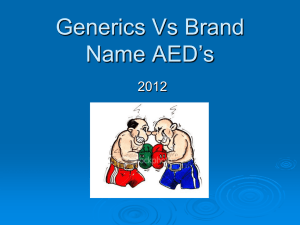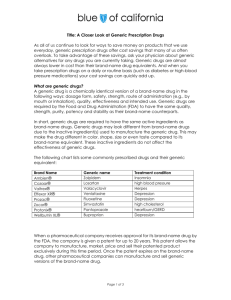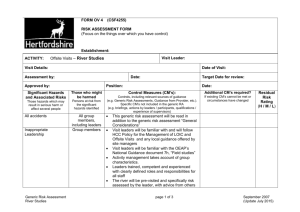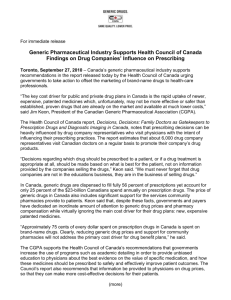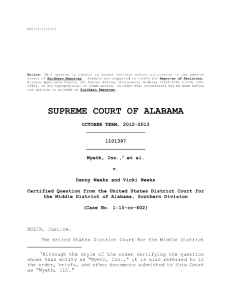Top 10 Facts on Generic Drugs - Blue Cross and Blue Shield of
advertisement
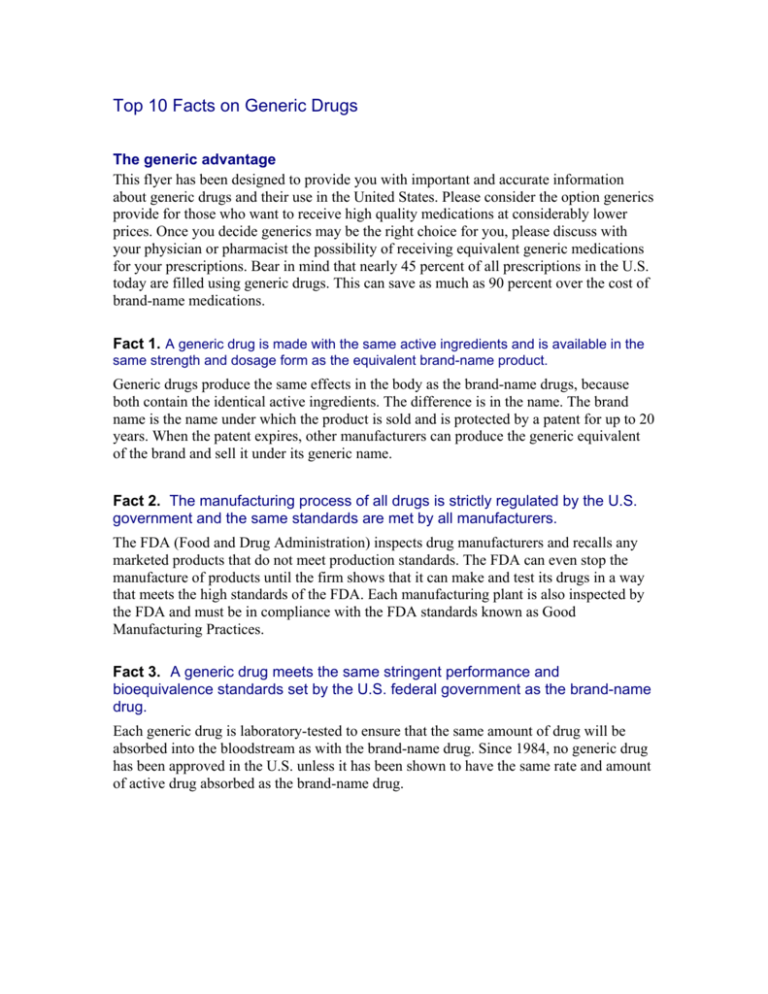
Top 10 Facts on Generic Drugs The generic advantage This flyer has been designed to provide you with important and accurate information about generic drugs and their use in the United States. Please consider the option generics provide for those who want to receive high quality medications at considerably lower prices. Once you decide generics may be the right choice for you, please discuss with your physician or pharmacist the possibility of receiving equivalent generic medications for your prescriptions. Bear in mind that nearly 45 percent of all prescriptions in the U.S. today are filled using generic drugs. This can save as much as 90 percent over the cost of brand-name medications. Fact 1. A generic drug is made with the same active ingredients and is available in the same strength and dosage form as the equivalent brand-name product. Generic drugs produce the same effects in the body as the brand-name drugs, because both contain the identical active ingredients. The difference is in the name. The brand name is the name under which the product is sold and is protected by a patent for up to 20 years. When the patent expires, other manufacturers can produce the generic equivalent of the brand and sell it under its generic name. Fact 2. The manufacturing process of all drugs is strictly regulated by the U.S. government and the same standards are met by all manufacturers. The FDA (Food and Drug Administration) inspects drug manufacturers and recalls any marketed products that do not meet production standards. The FDA can even stop the manufacture of products until the firm shows that it can make and test its drugs in a way that meets the high standards of the FDA. Each manufacturing plant is also inspected by the FDA and must be in compliance with the FDA standards known as Good Manufacturing Practices. Fact 3. A generic drug meets the same stringent performance and bioequivalence standards set by the U.S. federal government as the brand-name drug. Each generic drug is laboratory-tested to ensure that the same amount of drug will be absorbed into the bloodstream as with the brand-name drug. Since 1984, no generic drug has been approved in the U.S. unless it has been shown to have the same rate and amount of active drug absorbed as the brand-name drug. Fact 4. A generic drug is as safe and provides the same therapeutic effects as the brand-name product for patients of all ages. As a group, generic drugs have no proven age-related side effects that are different from brand-name drugs. Generics have been shown to be as safe as brand-name drugs and work no differently in children or the elderly. Fact 5. Many of the generic drugs approved by the FDA are manufactured by companies that also make brand-name drugs. Many more generic drugs will become available as brand-name drugs, such as Vasotec® and Prilosec®, lose patent protection. Fact 6. Health care professionals strongly support the use of generic drugs. The American Medical Association, the largest organization of medical doctors, states that generic drug products are acceptable for use by the American public. Most hospitals routinely use generic drugs for treatment of their patients. Fact 7. There were 77 generic drugs on the list of the top-200 drugs sold in the U.S. in the year 2000. In fact, the top drug sold as a new prescription in 2000 was the generic version of Vicodin®. Additionally, four of the top ten sellers by prescription volume in 2000 were generics. Fact 8. The American public spent over $130 billion dollars on prescription drugs in 2000. With the price of generic drugs averaging 15 to 60 percent less than the cost of brandname drugs, the American public can save billions of dollars by using generic drugs. Overall, this savings can help control the cost of health care in the U.S. without reducing the quality offered to patients. Fact 9. Generic drugs provide a valuable way for senior citizens to lower their cost of prescription medications. Senior citizens represent 13 percent of the U.S. population, and they account for 25 to 33 percent of the prescription drugs used each year. Senior citizens use an average of 11 different prescriptions per year. Because many people over the age of 65 have fixed incomes, a considerable amount of savings can be gained through the use of generic drugs. Fact 10. The decision to use generic medications is ultimately made through the cooperation of your physician, your pharmacist, and yourself. Ask your physician or pharmacist if any of the prescription medications that you are currently taking can be filled with a generic alternative. Once you begin using generic drugs whenever possible, you can start to reduce prescription drug costs while maintaining the same strength, dosage, and quality as the brand-name drug. ® Registered Marks Blue Cross Blue Shield Association
